Ranking of the best oil and vinegar containers for 2025

For a real housewife, the kitchen can look like a chemical laboratory. And just as in the laboratory you can easily find very aggressive substances, such as alkalis and acids, so in the kitchen. Citric and acetic acids are the most common. Vinegar is bought already diluted, with an acid content of 3 to 9%, but you can also purchase 70% essence.
Oil is also a frequent guest in the kitchen. It is difficult to find a house in which it would not be. And if the acids are characterized by increased aggressiveness, then the oil is high in fat content. Therefore, both require special storage utensils.
Storage is not the only issue. Salt and pepper shakers have long been an integral part of the serving, but real gourmets do not stop there, and add containers for liquid seasonings to them, with which everyone can make the finished dish tastier.Such dishes should differ not only in resistance to the aggressive effects of the products inside, but also in external attractiveness, a design that will suit the table setting.

Content [Hide]
- 1 A bit of history
- 2 Types of vegetable fats
- 3 Types of vinegar
- 4 Top Producers
- 5 Rating of the best containers for oil and vinegar
- 6 Where could I buy
- 7 How to choose
A bit of history
Both of these products have been known to mankind for a long time. The use of oil presumably dates back to the time when Neanderthals stopped eating raw food and started cooking it over a fire. True, it was still animal fat, since our ancient ancestors did not yet know how to get vegetable fat.
The merit of cultivation of oil plants belongs to three historical centers at once - Central Asian, Western Asian and Mediterranean. But the ancient Levant, located on the territory of modern Lebanon, Syria, Israel, Turkey, Cyprus and Egypt, is considered the ancestor of vegetable oil production.
Here, around 6000 BC.people guessed that they could not only eat olives, which they had known for a long time, but also squeeze oil out of them.
It was actively used in ancient Greece, and not only as an edible product. Athletes were smeared with it before competitions to protect them from the scorching sun, and also to make it harder for the enemy to capture them. It was in this country that olive oil received the status of a cult product. It was presented to the winners of the Olympic Games, presented to high-ranking officials, used in the manufacture of cosmetics and medical products.
Vinegar has also been known to people since antiquity. Its appearance is associated with the beginning of wine making. The first mention of wine and vinegar made from dates dates back to the time of Babylon, 5000 BC. According to one version, it was winemakers who accidentally invented vinegar when they forgot wine in open barrels, and as a result, it turned sour. Mentions of it can be found in the Old Testament, in the chronicles of Mesopotamia and the legends of Ancient China.
Types of vegetable fats
Currently, many types of vegetable oils are used in the food industry. The following are the most popular.
- Sunflower. Obtained from seeds of oil-bearing varieties of sunflower. It is the most common and popular in the territory of the Russian Federation.
- Olive (Provencal). Obtained from the fruit of the olive. Since this tree does not grow in Russia, all commercially available species are made abroad. This affects the price, which is much higher than other types of vegetable fats. Nevertheless, the demand for olive oil in our country is quite high.
- Corn. Obtained from corn seeds. It has a pleasant taste and smell. The color, depending on the grade of the feedstock, can range from light yellow to red-brown.
- Soy.Obtained from soybean seeds by extraction or mechanical method. Very popular in Asian countries, it was already known in ancient China. It came to Europe only in the 18th century.
- Linen. Obtained from flax seeds. It dries quickly as it polymerizes upon contact with oxygen. It is a source of the most valuable substances: oleic, linoleic and linolenic fatty acids, therefore it is often recommended by supporters of a healthy diet.
- Poppy. Extracted from poppy seeds. It is used not only in the food industry, but also in pharmaceuticals, cosmetology and even in painting.
- Beech. Rarely found in the sale of a product made from beech nuts. In their raw form, these nuts contain the alkaloid fagin, which can provoke a headache, but during heat treatment it is destroyed.
- Surepnoe (it is also rapeseed). A product that is gaining more and more popularity. In recent years, fields sown with rapeseed are as common as those sown with sunflower. Until the 60s. of the last century, it was used exclusively for technical purposes in the leather and textile industries. Later, a canola hybrid, the seeds of which did not contain toxic substances, made it possible to use it in the food industry, but the disadvantage is a large amount of trans fats.
- Sea buckthorn. Obtained from ripe fruits of sea buckthorn. It has an orange-red color and a characteristic smell, contains a lot of carotenoids. It is used not only in the food industry, but also for medical purposes, as well as in the manufacture of cosmetics.
- Walnut. A group of oils that includes pomace from walnuts, peanuts, brazil and pine nuts, cashews, macadamia, almonds, coconut, pecans, pistachios and hazelnuts.Each type of nuts has its own processing technology, but it is better to give preference to cold-pressed technology.
- Mustard. Obtained from mustard seeds by extraction or pressing. It is a source of fatty acids such as omega-3 and omega-6.
- Sesame. Extracted from Indian sesame seeds. It is a source of stearic, palmitic, myristic and other fatty acids useful for the body.
- Oil from apricot, grape, cherry, peach, watermelon, melon, plum pits. It is produced in small quantities from the kernels of the seeds of fruit crops. It is used both in the food industry, and in cosmetology and medicine.
- Avocado oil. It is extracted from ripe fruits by pressing methods. Has a greenish tint. It is widely used in cosmetology and medicine, can be eaten as a source of palmitic, stearic, linoleic and other fatty acids.
- Palm. It traces its history back to ancient Egypt. The most controversial product of all vegetable oils, which causes a lot of controversy about quality. Extracted from the pulp of the fruit of the oil palm. The product extracted from the seeds of these fruits is called palm kernel oil.
In addition to those listed, on sale you can find argan, milk thistle, rice bran, wheat germ, amaranth, hemp, camelina, safflower, truffle, pumpkin, cottonseed, and even tomato seed oils. Each of them has advantages and disadvantages, which are better to study in advance.
Types of vinegar
All types are divided into synthetic and natural. Synthetic is extracted from sawdust and other production waste.Unlike natural, it is practically odorless, but otherwise has similar properties.
Natural vinegar is divided according to the product from which it is produced. The main types are shown below.
- Alcoholic. Produced from ethyl alcohol. It can be either pure or flavored with spices or extracts of fragrant plants (thyme, basil, garlic, etc.).
- Apple and fruit. For cooking, apple cider and other fruit raw materials are used.
- Wine. It is based on the processing of grape wine materials. After several years of aging in wooden barrels, it becomes balsamic.
Whey, malt and other types are much less common.

Top Producers
In Russia, of all types of vegetable oils, the leader is production from sunflower seeds. The most popular brands of refined oil are:
- Oleina (Bunge Company);
- Zlato (agro-industrial group of companies "Yug Rusi");
- Ideal (Bunge Company);
- Golden Seed (agro-industrial group of companies "Yug Rusi");
- Mr.Ricco (Kazan Fat Plant JSC);
- Sloboda (JSC "EFKO").
Among the unrefined sunflower oils, the following brands are in the lead:
- Blago (Blago Company LLC);
- Kubanochka (LLC "Grand Star");
- Fragrant Sloboda (JSC EFKO);
- Gifts of Kuban (Company Blago LLC);
- Alyonushka (Agroplus LLC);
- Selyanochka (OOO Akvilon).
The best brands of vinegar produced by Russian manufacturers are listed below:
- Uncle Vanya (Ruspole brands group of companies);
- CHIM-CHIM (trademark of the company VIRTEX-FOOD, production in Berdsk);
- JV Mirny (JV Mirny LLC);
- Abriko (group of companies "IRGA group");
- Arivera (Arivera Group of Companies).
Rating of the best containers for oil and vinegar
This review presents a small number of all the available options for such dishes. Both low-cost budget models and those from another price category, which are distinguished by high-quality materials and outstanding design, are considered.
Rating of the best containers for oil and vinegar worth up to 1000 rubles
This collection presents budget products that are distinguished by convenience and practicality of use, as well as an affordable price.
Ravioil
votes 0
The average price is 390 rubles.

A small 100ml spray bottle is suitable not only for the seasonings mentioned above, but also for wine, soy sauce, lemon juice or plain water. Made from durable tempered glass and stainless steel.
- compact;
- uniform spray;
- lies comfortably in the hand.
- small volume.
Fusion. Spiral
votes 0
The average price is 408 rubles.

A bottle of original design will look great not only on a home dining table, but also in an expensive restaurant. The volume of a large vessel is 250 ml, a small one located behind the spiral - 30 ml. The bottle is made of durable glass, the cork is made of wood.
- outstanding design;
- Ease of use;
- environmentally friendly materials.
- no dispenser.
Home
votes 0
The average price is 514 rubles.

The set consists of two transparent glass bottles of square section, each with a volume of 500 ml, the width of the bottle is 7.1 cm. In addition to the corks, each of them comes with a dispenser. Can be used for thin and medium thick sauces. The walls of the bottles are thick and durable.
- stylish design;
- does not absorb odors;
- easy to clean;
- plugs are tight.
- sometimes there are bubbles in the walls of the bottles;
- The dispenser is made of plastic.
Elan gallery
votes 0
The average price is 729 rubles.
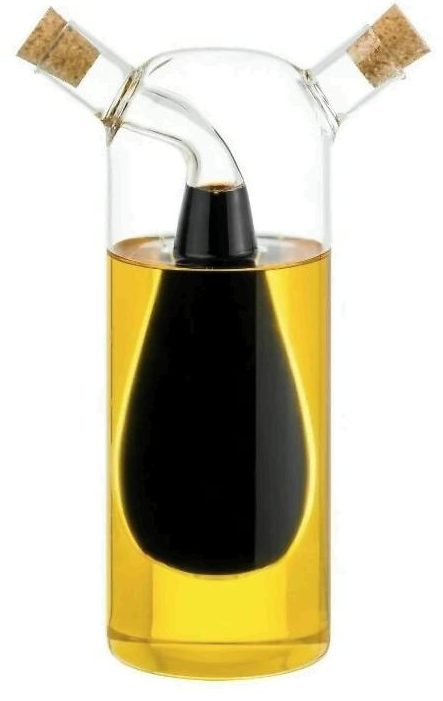
The original bottle made of transparent borosilicate glass, made according to the 2 in 1 principle, contains two containers with a volume of 340 and 80 ml. The total volume is 420 ml, the height is 18.5 cm, the width is 12 cm. The corks are made of wood.
- stylish gift wrapping;
- original design;
- comfortable volume.
- do not wash in the dishwasher and heat in the microwave;
- no dispenser.
Casalinga
votes 0
The average price is 832 rubles.
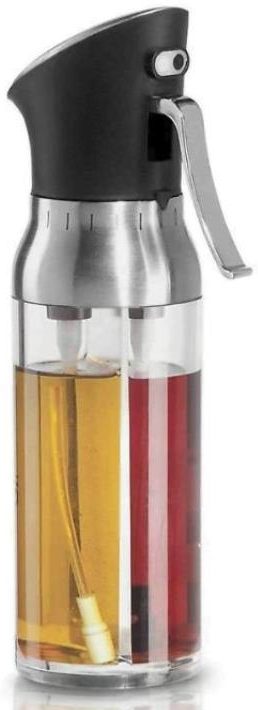
The bottle with a total volume of 200 ml is divided by a partition into two compartments, each of which holds 95 ml of liquid. Made of durable ABS plastic and polystyrene, some parts of the dispenser are metal. In order to pour liquid from a particular compartment, you need to move the dispenser cover to the desired division.
- convenient form;
- compactness;
- reliable dispenser.
- small volume;
- made of plastic.
Rating of the best containers for oil and vinegar costing from 1000 to 3000 rubles
This collection contains products that best combine price and quality. They are suitable for everyday use, and as an original gift.
Container with brush Sima-Land
votes 0
The average price is 1002 rubles.

Original dishes of small volume will not take up much space in the kitchen, but will make the cooking process much more convenient, and the consumption of oil, sauce or other liquid poured into it will be economical. Made from food grade plastic.
- convenient form;
- economical use of the product;
- compact size;
- can be used for different liquids.
- plastic processing quality.
Fusion. Rybka
votes 0
The average price is 1120 rubles.

An original bottle with a second container in the form of a fish inside will become a real decoration of the table. Experimenting with spices of different colors, you can make various interesting compositions. The bottle is made of durable glass, the cork is made of wood. The volume of a large bottle is 420 ml, fish - 50 ml. Size - 12.4 x 10 x 12 cm.
- original form;
- suitable for any liquid seasonings and sauces;
- environmentally friendly materials.
- there is no dispenser;
- uncomfortable to wash.
Agnes
votes 0
The average price is 1185 rubles.
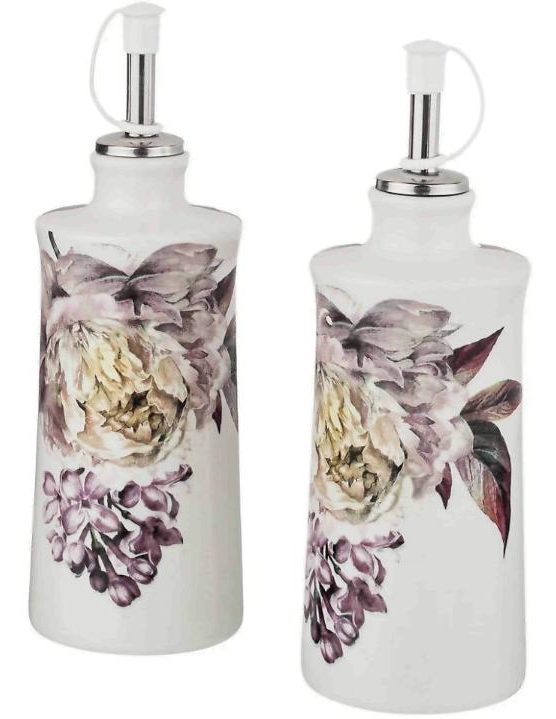
A set of two ceramic vessels with dispensers with a volume of 300 ml will win the heart of connoisseurs of beauty. Several color options allow you to choose the right option. The dispenser is made of metal.
- high quality drawings;
- several options for ornament;
- exquisite design;
- convenient dispenser;
- easy to wash;
- optimal volume.
- not found.
Bottle set Chef with cart ProMarket
votes 0
The average price is 1523 rubles.

This unusual set will be a great addition to the table setting or an unusual gift and will cheer you up with its appearance. Two glass bottles of 150 ml each are firmly placed in the trolley thanks to the square section. All parts of the set are easy to clean.
- original design;
- convenient dispensers;
- easy to wash.
- flaws in the painting of the stand;
- not suitable for every serving.
Simplicity White
votes 0
The average price is 1749 rubles.
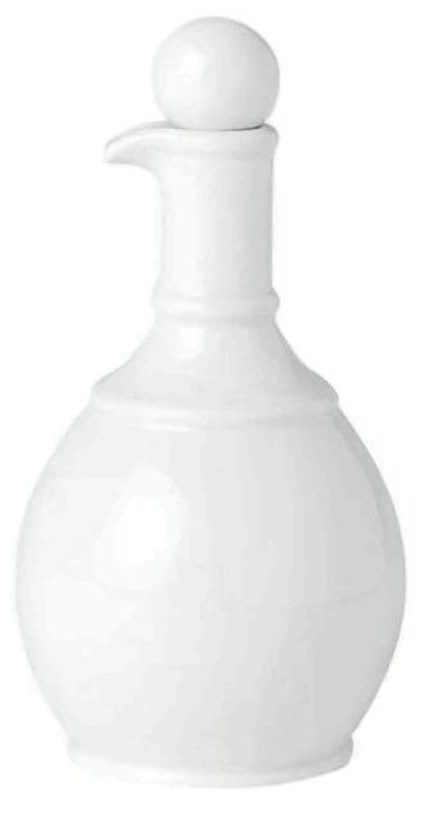
The product of the British manufacturer Steelite from the Simpl white series is distinguished by exquisite simplicity and elegance. White color will be appropriate for almost any serving. Made from porcelain. Height - 145 mm, diameter - 55 mm. Volume - 170 ml.
- made of high quality porcelain;
- stylish design;
- easy to clean;
- does not absorb odors.
- beats easily;
- cork does not fit snugly;
- there is no dispenser;
- small volume.
Rating of the best containers for oil and vinegar worth over 3000 rubles
This category presents expensive and exquisite goods from leading companies that will satisfy the most demanding taste and can be a wonderful gift.
Frabosk
votes 0
The average price is 3002 rubles.
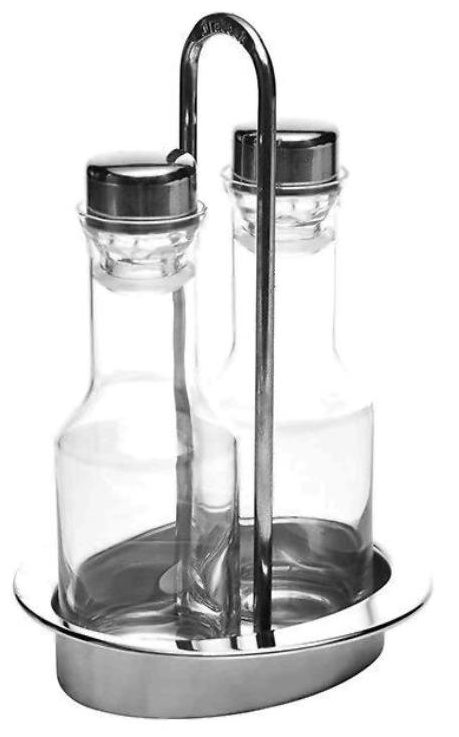
A strict but stylish set of glass and metal is not a shame to put on the table even in a fashionable restaurant. The diameter of the bottles is 13.8 cm. Stainless steel, from which the stand and part of the corks are made, is resistant to scratches and temperature effects and retains its presentation for a long time.
- universal style;
- convenient carrying handle;
- corporate engraving;
- manufacturer's warranty.
- dispenser missing.
Tescoma Vitamino
votes 0
The average price is 3159 rubles.
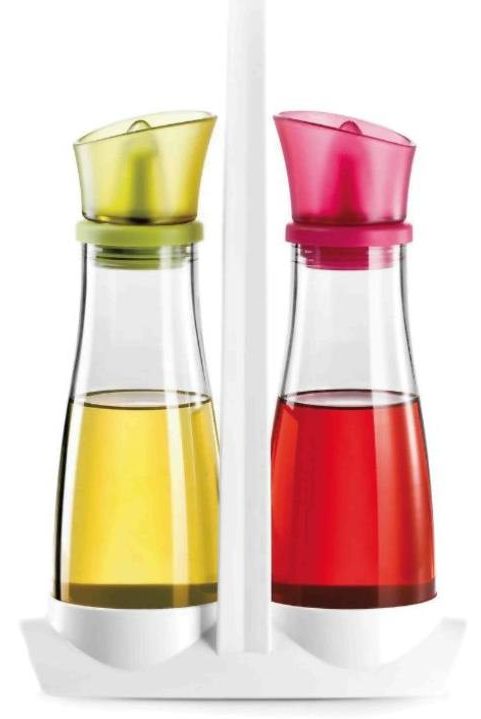
Two borosilicate glass containers on a plastic convenient stand will decorate any kitchen. The dispensers are made of durable plastic in bright colors. The volume of each bottle is 250 ml. Any other liquid spices can be stored in the set.
- quality glass;
- convenient volume;
- the presence of a stand;
- Can be washed in the dishwasher;
- three years warranty.
- plastic dispenser.
trendglas
votes 0
The average price is 3695 rubles.
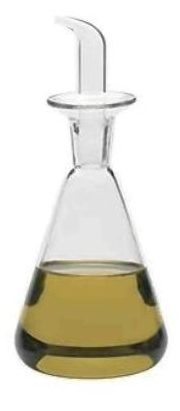
Stylish transparent glass container will perfectly fit into any type of serving. The glass stopper is tightly ground to the neck and will not allow seasonings to spill, and the wide edges of the neck will not allow liquid to spill onto the walls. Volume - 250 ml. The bottle has a stable base. Height - 20 cm, bottom diameter - 8.5 cm. Production - Hungary.
- universal style;
- quality glass;
- sustainable form.
- there is no dispenser;
- high price.
Server
votes 0
The average price is 6820 rubles.
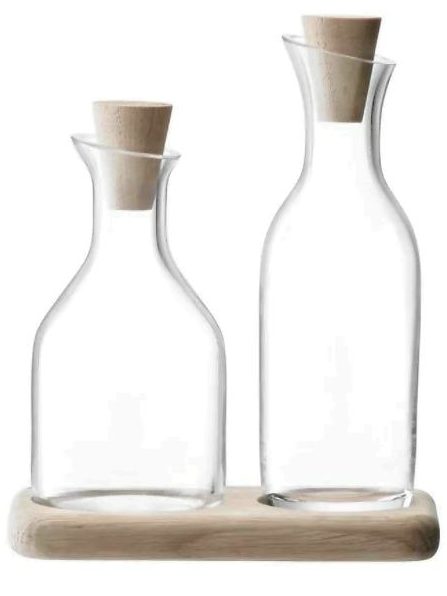
Finely shaped blown glass vessels are suitable for any type of serving. A convenient expanding neck allows you to gently add seasonings without fear of streaks on the walls of the bottles. The set is complemented by an elegant oak stand. The volume of each carafe is 300 ml.
- gift wrap;
- handmade glass;
- convenient form;
- elegant design.
- no dispenser;
- can only be washed by hand;
- high price.
Emile Henry
votes 0
The average price is 7680 rubles.
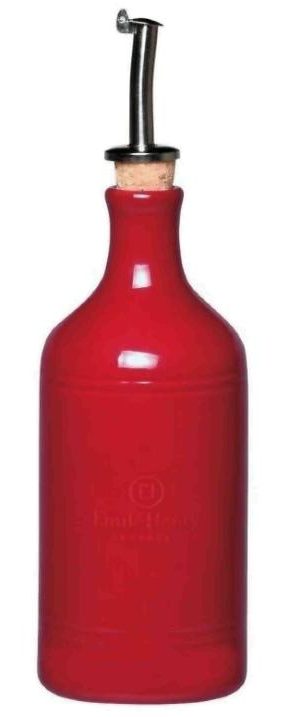
The refined simplicity of this product of the famous French brand will make it a real decoration of the table. Quality and reliability, safe materials, ease of use complete the aesthetic pleasure. Volume - 450 ml. There are several color options. Made of durable ceramic, the dispenser is made of steel.
- quality;
- prestigious brand;
- safe materials;
- convenient dispenser;
- easy to clean.
- high price.
Where could I buy
Containers for liquid spices can be found both in regular stores and on the Internet by paying for the purchase online.The second method will save time and money, since goods are often cheaper on virtual sites than in real sales. Another advantage is the unlimited choice of shapes, sizes and colors of containers offered by virtual sites.
How to choose
When choosing such a subject, one must first of all proceed from the question of expediency. If you yourself and your guests are not used to adding any seasonings to salads and other dishes, then this item in the table setting will be redundant. If desired, you can limit yourself to a small set of two vessels, one of which will contain oil, the other - vinegar. If, on the contrary, there is a place and a desire for experiments, you can take a large set that will allow you to use several types of seasonings at once.
You also need to pay attention to how the selected dishes fit the usual table setting in terms of style, color and material from which they are made.
Such dishes can be considered not only as an element of serving, but also as a household item. In this case, you need to focus on the frequency of use and the number of types of seasonings that regularly appear in the kitchen, and choose the number and volume of containers based precisely on their practical expediency. Also, do not forget that the dishes should be safe, not slippery and comfortable.
An interesting addition may be the presence of a dispenser or sprayer, decorative trim or engraving. Vessels made according to the “two in one” principle look original.
Oil and vinegar containers are a touch that can transform an ordinary meal, adding personality and delighting it with new taste sensations. And a well-fed person is a happy person, and this is true not only for gourmet gourmets, but also for each of us, regardless of gender and age.
new entries
Categories
Useful
Popular Articles
-

Top ranking of the best and cheapest scooters up to 50cc in 2025
Views: 131650 -

Rating of the best soundproofing materials for an apartment in 2025
Views: 127689 -

Rating of cheap analogues of expensive medicines for flu and colds for 2025
Views: 124518 -

The best men's sneakers in 2025
Views: 124031 -

The Best Complex Vitamins in 2025
Views: 121938 -

Top ranking of the best smartwatches 2025 - price-quality ratio
Views: 114979 -

The best paint for gray hair - top rating 2025
Views: 113394 -

Ranking of the best wood paints for interior work in 2025
Views: 110318 -

Rating of the best spinning reels in 2025
Views: 105328 -

Ranking of the best sex dolls for men for 2025
Views: 104365 -

Ranking of the best action cameras from China in 2025
Views: 102215 -

The most effective calcium preparations for adults and children in 2025
Views: 102011









